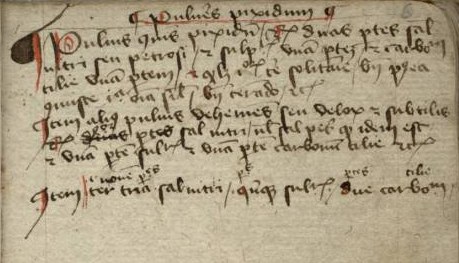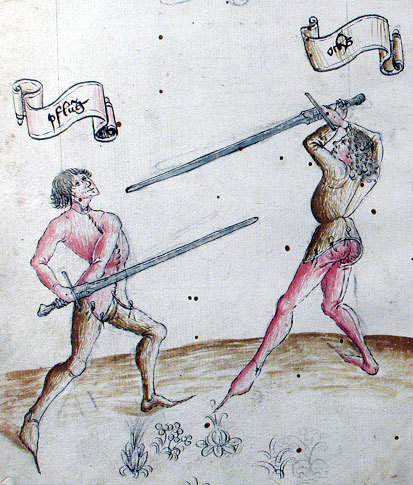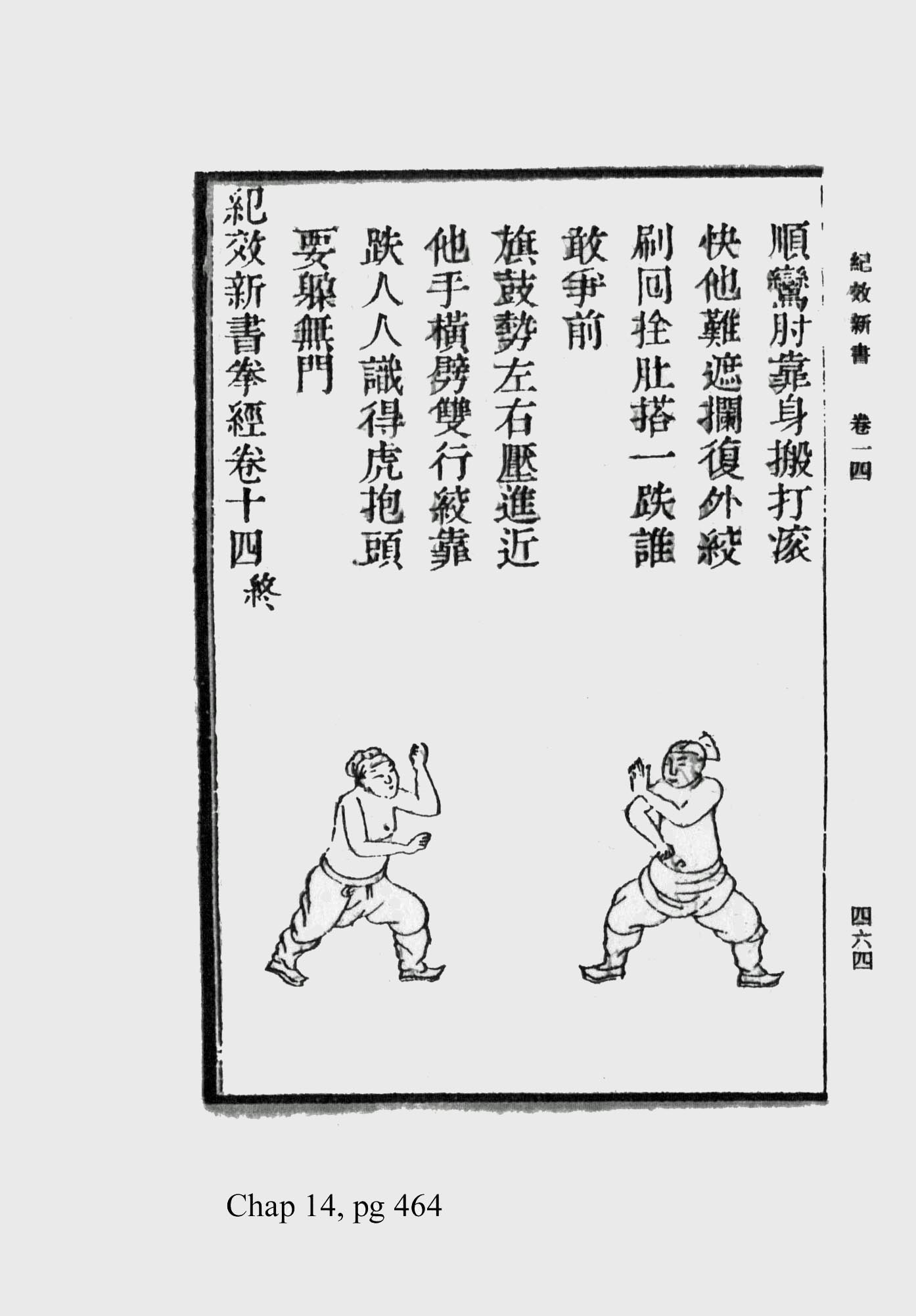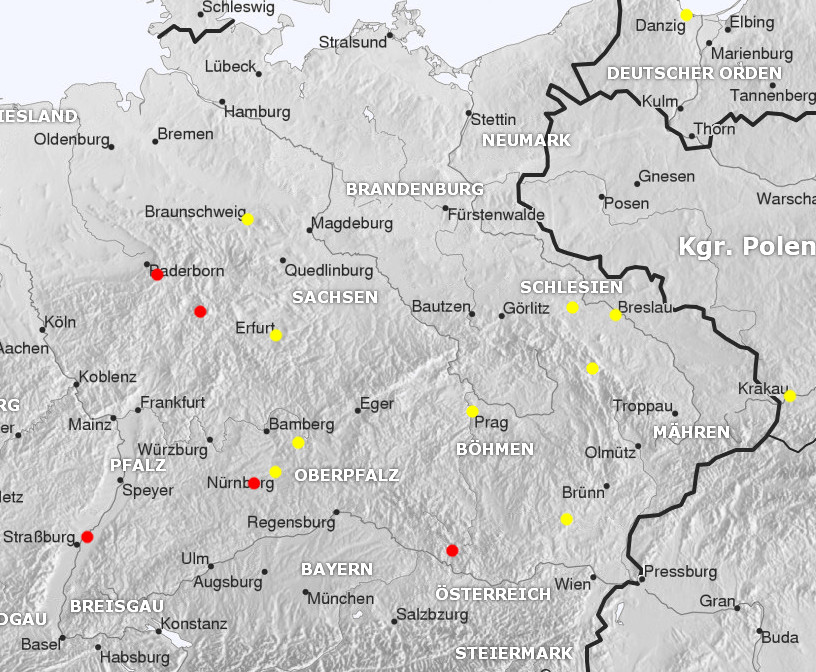|
Nürnberger Handschrift GNM 3227a
Codex 3227a of the in Nuremberg (also known as ''Hs. 3227a'', ''GNM 3227a'', ) is a manuscript of 169 folia, dated to the close of the 14th century. Its text is written in Latin and German. The German portions have been identified as in East Central German dialect. The composition of the manuscript is sometimes dated to 1389 on the basis of the calendar on fol. 83v which covers the years 1390–1495 (assuming that the scribe compiled the calendar for future reference only), but it has been noted that nothing precludes a date in the first quarter of the 15th century. By the late 15th century, the manuscript was owned by Nicolaus Pol, who left the inscription . Pol is known as the personal surgeon to the emperors at Innsbruck from 1495. After Pol's death in 1532, his library, presumably including this manuscript, passed to Innichen Abbey in South Tyrol. The fate of the manuscript during the 17th and 18th centuries is unknown, but it was part of the library of Hans Freiher ... [...More Info...] [...Related Items...] OR: [Wikipedia] [Google] [Baidu] |
German School Of Fencing
The German school of fencing (') is a system of combat taught in the Holy Roman Empire during the Late Medieval, German Renaissance, and Early Modern periods. It is described in the contemporary Fechtbücher ("fencing books") written at the time. The geographical center of this tradition was in what is now Southern Germany including Augsburg, Frankfurt, and Nuremberg. During the period in which it was taught, it was known as the ', or the ''"Art of Fighting"''. The German school of fencing focuses primarily on the use of the two-handed longsword; it also describes the use of many other weapons, including polearms, medieval daggers, messers (with or without a buckler), and the staff, as well as describing mounted combat and unarmed grappling (''ringen''). Most authors of writings on the system are, or claim to be, in the tradition of the 14th-century master Johannes Liechtenauer. The earliest surviving treatise on Liechtenauer's system is a manuscript dated to 1389, known a ... [...More Info...] [...Related Items...] OR: [Wikipedia] [Google] [Baidu] |
Alchemical Documents
Alchemy (from Arabic: ''al-kīmiyā''; from Ancient Greek: χυμεία, ''khumeía'') is an ancient branch of natural philosophy, a philosophical and protoscientific tradition that was historically practiced in China, India, the Muslim world, and Europe. In its Western form, alchemy is first attested in a number of pseudepigraphical texts written in Greco-Roman Egypt during the first few centuries AD.Principe, Lawrence M. The secrets of alchemy'. University of Chicago Press, 2012, pp. 9–14. Alchemists attempted to purify, mature, and perfect certain materials. Common aims were chrysopoeia, the transmutation of "base metals" (e.g., lead) into "noble metals" (particularly gold); the creation of an elixir of immortality; and the creation of panaceas able to cure any disease. The perfection of the human body and soul was thought to result from the alchemical ''magnum opus'' ("Great Work"). The concept of creating the philosophers' stone was variously connected with all of these ... [...More Info...] [...Related Items...] OR: [Wikipedia] [Google] [Baidu] |
Combat Treatises
Combat (French for ''fight'') is a purposeful violent conflict meant to physically harm or kill the opposition. Combat may be armed (using weapons) or unarmed ( not using weapons). Combat is sometimes resorted to as a method of self-defense, or can be used as a tool to impose one's will on others. An instance of combat can be a stand-alone confrontation or a small part of a much larger violent conflict. Instances of combat may also be benign and recreational, as in the cases of combat sports and mock combat. Combat may comply with, or be in violation of local or international laws regarding conflict. Examples of rules include the Geneva Conventions (covering the treatment of people in war), medieval chivalry, the Marquess of Queensberry rules (covering boxing) and several forms of combat sports. Hand-to-hand combat Hand-to-hand combat (melee) is combat at very close range, attacking the opponent with the body ( striking, kicking, strangling, etc.) and/or with a melee weapo ... [...More Info...] [...Related Items...] OR: [Wikipedia] [Google] [Baidu] |
14th-century Manuscripts
As a means of recording the passage of time, the 14th century was a century lasting from 1 January 1301 ( MCCCI), to 31 December 1400 ( MCD). It is estimated that the century witnessed the death of more than 45 million lives from political and natural disasters in both Europe and the Mongol Empire. West Africa experienced economic growth and prosperity. In Europe, the Black Death claimed 25 million lives wiping out one third of the European population while the Kingdom of England and the Kingdom of France fought in the protracted Hundred Years' War after the death of Charles IV, King of France led to a claim to the French throne by Edward III, King of England. This period is considered the height of chivalry and marks the beginning of strong separate identities for both England and France as well as the foundation of the Italian Renaissance and Ottoman Empire. In Asia, Tamerlane (Timur), established the Timurid Empire, history's third largest empire to have been ever establish ... [...More Info...] [...Related Items...] OR: [Wikipedia] [Google] [Baidu] |
Onomatomancy
Onomancy (or nomancy) is divination based on a subject's name. Onomancy was popular in Europe during the Late Middle Ages but is said to have originated with the Pythagoreans. Several methods of analyzing a name are possible, some of which are based on arithmancy or gematria. An early example of onomancy is found in the ''Secretum Secretorum''. The system given there involves adding up the numerical values of the letters in the names of two antagonists, dividing the total for each person by 9, and comparing the remainders with a table which predicts the victor. In China, Taiwan, and Japan, onomancy is known as 姓名判断 (Chinese: ''xingming panduan''; Japanese: ''seimei handan''). It can take several forms, but the most popular is based on the character strokes in the subject's written name, and the result number will be modulo 81, the remainder In mathematics, the remainder is the amount "left over" after performing some computation. In arithmetic, the remainder is the inte ... [...More Info...] [...Related Items...] OR: [Wikipedia] [Google] [Baidu] |
Ringen
''Ringen'' is the German language term for grappling (wrestling). In the context of the German school of historical European martial arts during the Late Middle Ages and the German Renaissance, ''Ringen'' refers to unarmed combat in general, including grappling techniques used as part of swordsmanship. The German tradition has records of a number of master-''Ringer'' of the 15th to 16th centuries specializing in unarmed combat, such as Ott Jud. Medieval and early Renaissance wrestling treatises present both sport and combat techniques together as one art. The distinction is made more frequently by modern practitioners than is present in historical sources, but in a select few examples the terms for sportive grappling or ''geselliges Ringen'' and earnest unarmed combat or ''Kampfringen'' (where ''Kampf'' is the Early Modern German term for "war" or ''battle'') were used to describe specific techniques which were only suitable for one scenario or the other. There are no known sour ... [...More Info...] [...Related Items...] OR: [Wikipedia] [Google] [Baidu] |
Liber Ignium
The ''Liber Ignium ad Comburendos Hostes'' (translated as ''On the Use of Fire to Conflagrate the Enemy'', or ''Book of Fires for the Burning of Enemies'', and abbreviated as ''Book of Fires'') is a medieval collection of recipes for incendiary weapons, including Greek fire and gunpowder, written in Latin and allegedly written by a certain Marcus Graecus ("Mark the Greek")—a person whose existence is debated by scholars. The work has been subjected to numerous academic analyses, resulting in contradictory conclusions vis-a-vis origin and influence on its contemporaries.Partington, James Riddick. A History of Greek Fire and Gunpowder, The Johns Hopkins University Press, 1998, pp. 58-60 One of the most influential studies of the ''Liber Ignium'' was conducted by Marcellin Berthelot which is cited in 20th century works on the topic. Contents The ''Liber Ignium'' is a collection of 35 recipes without any internal classification, as it was typical of "secret recipe" list of the er ... [...More Info...] [...Related Items...] OR: [Wikipedia] [Google] [Baidu] |
Combat Treatise
Martial arts manuals are instructions, with or without illustrations, specifically designed to be learnt from a book. Many books detailing specific techniques of martial arts are often erroneously called manuals but were written as treatises. Prose descriptions of martial arts techniques appear late within the history of literature, due to the inherent difficulties of describing a technique rather than just demonstrating it. The earliest extant manuscript on armed combat (as opposed to unarmed wrestling) is Royal Armouries Ms. I.33 ("I.33"), written in Franconia around 1300. Not within the scope of this article are books on military strategy such as Sun Tzu's ''The Art of War'' (before 100 BC) or Publius Flavius Vegetius Renatus' '' De Re Militari'' (4th century), or military technology, such as ''De rebus bellicis'' (4th to 5th century). Predecessors Some early testimonies of historical martial arts consist of series of images only. The earliest example is a fresco in tom ... [...More Info...] [...Related Items...] OR: [Wikipedia] [Google] [Baidu] |
Historical European Martial Arts Revival
History (derived ) is the systematic study and the documentation of the human activity. The time period of event before the invention of writing systems is considered prehistory. "History" is an umbrella term comprising past events as well as the memory, discovery, collection, organization, presentation, and interpretation of these events. Historians seek knowledge of the past using historical sources such as written documents, oral accounts, art and material artifacts, and ecological markers. History is not complete and still has debatable mysteries. History is also an academic discipline which uses narrative to describe, examine, question, and analyze past events, and investigate their patterns of cause and effect. Historians often debate which narrative best explains an event, as well as the significance of different causes and effects. Historians also debate the nature of history as an end in itself, as well as its usefulness to give perspective on the problems of the p ... [...More Info...] [...Related Items...] OR: [Wikipedia] [Google] [Baidu] |
Longsword
A longsword (also spelled as long sword or long-sword) is a type of European sword characterized as having a cruciform hilt with a grip for primarily two-handed use (around ), a straight double-edged blade of around , and weighing approximately . The "longsword" type exists in a morphological continuum with the medieval knightly sword and the Renaissance-era Zweihänder. It was prevalent during the late medieval and Renaissance periods (approximately 1350 to 1550), with early and late use reaching into the 12th and 17th centuries. Names English The longsword has many names in the English language, which, aside from variant spellings, include terms such as "bastard sword" and "hand-and-a-half sword." Of these, "bastard sword" is the oldest, its use being contemporaneous with the weapon's heyday. The French ' and the English "bastard sword" originate in the 15th or 16th century, originally in the general sense of "irregular sword, sword of uncertain origin", but by the mid ... [...More Info...] [...Related Items...] OR: [Wikipedia] [Google] [Baidu] |
Johannes Liechtenauer
Johannes Liechtenauer (also ''Lichtnauer'', ''Hans Lichtenawer'') was a German fencing master who had a great level of influence on the German fencing tradition in the 14th century. Biography Liechtenauer seems to have been active during the mid-to-late 14th century. The only extant biographical note on Liechtenauer is found in GNM Hs. 3227a (dated c. 1400), which states that "Master Liechtenauer learnt and mastered he art of the swordin a thorough and rightful way, but he did not invent it or make it up himself, as it is stated before. Instead, he travelled across and visited many lands for the sake of this rightful and true art, as he wanted to study and know it." His surname indicates he was from a place called ''Liechtenau'' (modern ''Lichtenau''). There are several places with this name. Massmann (1844) mentions five candidate locations: Lichtenau im Mühlkreis in Upper Austria; Lichtenau in Franconia, Nuremberg; Lichtenau on the Rhine, Baden, near Strasbourg; Licht ... [...More Info...] [...Related Items...] OR: [Wikipedia] [Google] [Baidu] |








.jpg)
